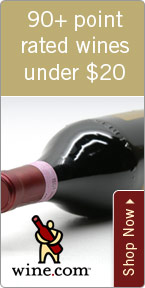What To Make Of Cloudy Wines?

Wednesday - February 10, 2006
| Share
 Del.icio.us
Del.icio.usIf you are an avid wine drinker, I’m sure you’ve found a glass of cloudy wine some time during your wine-drinking days and nights. Have no fear, for Vino Sense is here. No, I can’t instantly make the wine clear and bright for you, but what I can do is explain why clarity is not as important as the flavor and character of the wine.
First of all, why is the wine cloudy? All wines start out cloudy. During the winemaking process, after the grapes are pressed and the juice or fermented wine is run off of the skins, stems and pits, there are still plenty of particles of residue that come with it. Most winemakers will try to let the wine rest for a period to allow the particles to settle to the bottom of the tank or barrel. Then the wine is decanted off these bigger particles.
But because this settling period is short for some, as well as the fact that some fine particles do not settle very well, wine-makers must “fine” the wine. This is a process where winemakers must add a fining agent that adheres to these small particles in the wine allowing it to settle to the bottom of the container and clarifying the wine. These agents include some things that you may not associate with winemaking - egg whites, bentonite (a specific type of clay), isinglass (a protein obtained from bladders of sturgeon and freshwater fish) and casein (a protein derived from milk) are all common in the use of clarifying wines.
Another process that is used to clarify wines is centrifuging. The wine is basically put in a machine that does the same action as a washing machine on rinse cycle, but many times faster.
Now, if none of these are enough to make the wine clear, the last resort for a winemaker is to filter the wine. This involves forcing the wine through a membrane or barrier to remove particles all the way down to microscopic in size. This not only eliminates the solids, but also bacteria and yeast that could produce a faulty wine. Yes, there is the rare occurrence of a faulty wine that has not been filtered that has a bacterial taint. But these almost never get to the public, as most wines must go through tasting and chemical analysis before being labeled and sold.
Finally, you end up with a clear wine. Winemakers that use only some of these processes or none of them at all end up with wines that are cloudy.
Now most people like wines that are clear and are quite offended if a wine is hazy or has a slight deposit in the bottle. But as you can see, some of these processes are quite harsh on the wine, especially the filtering process. Many winemakers - and I would venture to say the best winemakers - believe that the filtering process not only takes out particles in the wine, it also takes out some of the flavor. Several winemakers I have spoken with believe it strips away flavor and character from the finished wine. One went as far as comparing it to “raping the wine of its life and flavor.”
On more than one occasion, I’ll taste a wine from barrel and like it, and when it is bottled, it tastes different, dull and septic. What happened? “We filtered the wine,” is quite often the response. Or as one wine importer says, “Nothing added, nothing taken out.”
There’s flavor in them particles. I understand that the general public doesn’t fully accept cloudy wines. Perhaps they think that it is a sign of faulty winemaking. But in my own experience, the wines that are not filtered heavily (or at all) have more life and vibrance to them. They also age more gracefully, if that is something you like your wines to do.
I am not saying that all cloudy wines are great, or that all clear wines could be better. I just want people to realize that cloudy wine should not be tossed out just because it doesn’t have the clarity of bottled water. After all, I’ve never ordered a bottle of wine because of its color or because of its clarity. To me it’s all about the flavor.
Recommended “cloudy” wines: * 2004 Whitcraft Morning Dew Ranch Pinot Noir, Anderson Valley $45. This is one of the most impressive Pinot Noirs from the 2004 vintage period. Mary had a little lamb, little lamb.
* 2003 Robert-Denogent Macon Fuisse ‘Les Taches’$23. This Chardonnay is from Southern Burgundy, creamy, loaded with ripe almost tropical fruit, great texture and lengthy aftertaste. Yummy with creamy pasta.
* 2002 Sirita Merlot, Napa Valley $36. Yes, I do drink Merlot, but only the good ones. This is berry heaven, beautiful complexity and rich, deep flavor. Try with raised or grilled beef.
Roberto Viernes is a master sommelier. E-mail .(JavaScript must be enabled to view this email address)E-mail this story | Print this page | Comments (0) | Archive | RSS Comments (0) |
Most Recent Comment(s):












